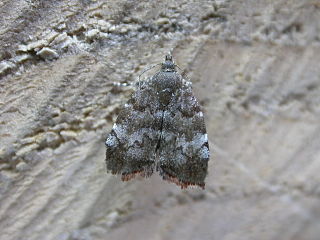
Choreutidae, or metalmark moths, are a family of insects in the lepidopteran order whose relationships have been long disputed. It was placed previously in the superfamily Yponomeutoidea in family Glyphipterigidae and in superfamily Sesioidea. It is now considered to represent its own superfamily. The relationship of the family to the other lineages in the group "Apoditrysia" need a new assessment, especially with new molecular data.

Anthophila fabriciana, also known as the common nettle-tap, is a moth of the family Choreutidae first described in 1767 by Carl Linnaeus. The moth can be found flying around stinging nettles during the day.

Prochoreutis myllerana, Miller’s nettle-tap or small metal-mark, is a moth of the family Choreutidae found in Asia and Europe. Miller's nettle-tap was first described by Johan Christian Fabricius in 1794 from a specimen found in Sweden.

Choreutis nemorana, the fig-tree skeletonizer moth or fig leaf roller, is a species of moth of the family Choreutidae.

Prochoreutis sestediana, also knowns as the silver-dot metal-mark is a moth of the family Choreutidae found in Asia and Europe. It was first described by Johan Christian Fabricius in 1776 from a specimen found in Kiel, Germany.
Tortyra vividis is a moth of the family Choreutidae. It is known from Cuba.
Tortyra ignita is a moth of the family Choreutidae. It is known from Cuba.
Tortyra fulgens is a moth of the family Choreutidae. It was described by Cajetan Felder, Rudolf Felder and Alois Friedrich Rogenhofer in 1875 and is known from Colombia, Brazil and Bolivia.
Tortyra aurofasciana is a moth of the family Choreutidae. It is known from the West Indies.
Telosphrantis is a genus of moths in the family Choreutidae, containing only one species, Telosphrantis aethiopica, which is known from Ethiopia.
Tebenna agelasta is a moth of the family Choreutidae. It is known from Uganda.

Tebenna gnaphaliella, the everlasting tebenna moth, is a moth of the family Choreutidae. It is found from Florida to California and north at least to New Hampshire.

Tebenna piperella is a moth of the family Choreutidae. It is known from Canada, including British Columbia and Alberta.
Prochoreutis holotoxa is a moth of the family Choreutidae. It is known from China (Shanxi), France (Alps), Italy, Austria (Tirol), Switzerland (Zermatt), Romania and Russia (Siberia).

Choreutis pariana, the apple-and-thorn skeletonizer or apple leaf skeletonizer, is a moth of the family Choreutidae. The moth was first described by the Swedish entomologist Carl Alexander Clerck in 1759. It is native to Eurasia and was introduced to New England, USA in 1917.

Brenthia is a genus of moths in the family Choreutidae.

Prochoreutis is a genus of moths in the family Choreutidae.
Choreutis aegyptiaca is a species of moth of the family Choreutidae. It is found in the India, Nepal, Israel, Saudi Arabia, the United Arab Emirates, Yemen, Egypt, La Réunion, Nepal, Oman, Uganda, Namibia and South Africa.
Millieriidae is a small family of moths in the lepidopteran order. It was described as by Henry Tibbats Stainton in 1854 as a subfamily of Choreutidae.









